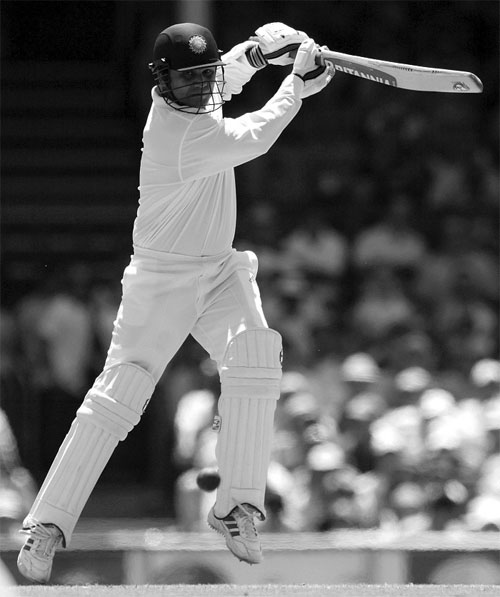
Cricket came alive with a spectacular innings of 208 by Rohit Sharma in the second ODI between India and Sri Lanka at Mohali on Wednesday. It reminded one of the famous advise that cricket legend Ranjitsinhji gave to a young CK Nayudu on batting. He said: “Balla seedha rakhe, jor se maro, aur ghabrao mat (Keep the bat straight, hit hard and do not worry).” Rohit’s third double century in one-day cricket was not just played in that fashion, but also with effortless style and grace.
The knock takes one back to some historic batting performances by Indian batsmen over the years. The first ever significant innings played by an Indian was by the great Ranjitsinhji for England against Australia in 1896 at the Old Trafford, Manchester, when he hammered an unbeaten 154. A century on debut. Ranjitsinhji, popularly called “the wizard of the willow,” proved to the cricketing world that an Indian could also play cricket. India, however, needed to prove its cricketing status in India. The next glorious innings was played by CK Nayudu. He scored a breathtaking 153 against the visiting MCC side led by AH Gilligan in Mumbai. He hit 11 sixes and 13 fours and dominated the MCC attack, very similar to the way Rohit and Virat Kohli did against Sri Lanka. Nayudu’s batting played an important role in establishing India as a Test playing nation. This innings was played even before the Board of Control for Cricket in India (BCCI) was formed.
Lala Amarnath, thereafter, created history when he scored the first ever century for India in the first Test match played on home soil at the Bombay Gymkhana in 1933. His innings was described as one that included shots which travelled to the boundary like bullets. This innings was significant — it was a performance that stood out in India’s fight for Independence.
Mushtaq Ali and Vijay Merchant’s centuries at Manchester in the 2nd Test against England in 1936 were the first two 100+ knocks ever by Indian cricketers overseas. A true milestone, as India posted its first 200-run opening partnership.
Thereafter, there were many wonderful performances by Indian batsmen such as Vijay Hazare, Vinoo Mankad, Vijay Merchant, PR Umrigar, Dattu Phadkar, Vijay Manjrekar, Nawab of Pataudi Jr and many more.
The innings that once again brought Indian cricket to the fore was the 212 scored by Dilip Sardesai against the West Indies in the first Test at Jamaica in 1971, after India were reeling at 75 for 5. The Test ended in a draw after the West Indies were made to follow-on, which was a major confidence booster for the Indian side.
Following this match, the young Sunil Gavaskar made his Test debut. He scored a record 774 runs in the series. In the fifth Test at Port of Spain, Gavaskar made 124 in the first innings and 220 in the second braving an agonising toothache, ensuring that India drew the match.
India did finally go on to win the series against the mighty West Indies and the subsequent series against England. The two overseas victories are viewed as the renaissance of Indian cricket.
Gavaskar, along with Gundappa Vishwanath, Mohinder Amarnath and Dilip Vengsarkar, played some significant innings in the 70s and 80s but the icing on the cake was the 175 that Kapil Dev hit against Zimbabwe at Turnsbridge Wells in the 1983 World Cup. He hit 6 sixes and 16 fours and changed the fortune of the Indian side that slumped to 17 for 5.
After the 1983 World Cup triumph, one-day cricket found a firm footing in India. The next devastating innings was played by Sachin Tendulkar, who scored 143 at Sharjah against Australia in 1998. The powerful hitting that he displayed, along with some classical stroke-play, marked the beginning of a series of joyous knocks played by many Indians subsequently.
The second Test against Australia at Kolkata in 2001 witnessed the stunning innings of 281 played by VVVS Laxman. Along the very dependable Rahul Dravid, who also slammed a big hundred, Laxman played one of the best innings in the game’s history. India were down and out and his effort led to a victory that seemed impossible after the hosts were made to follow-on. The mighty Australians were finally conquered as India established themselves as one of the foremost sides in world cricket.
Swashbuckling batsman Virendra Sehwag was a cricket connoisseur’s delight in the first decade of this century. He has the distinction of scoring two triple centuries in Test cricket and the highest score by an Indian — 319 versus South Africa at Chennai in 2008.
The year 2017 has seen some brilliant knocks by Indian batsmen like Virat Kohli, Shikhar Dhawan, MS Dhoni, Cheteshwar Pujara, KL Rahul, Murali Vijay, and Hardik Pandya.
The Indian women’s team is also not far behind. The 171 by Harmanpreet Kaur against Australia in the semifinal of the 2017 World Cup was as entertaining and memorable as the ones played by Kapil, Sehwag, Kohli or Rohit.
(The author is a former India cricketer)



